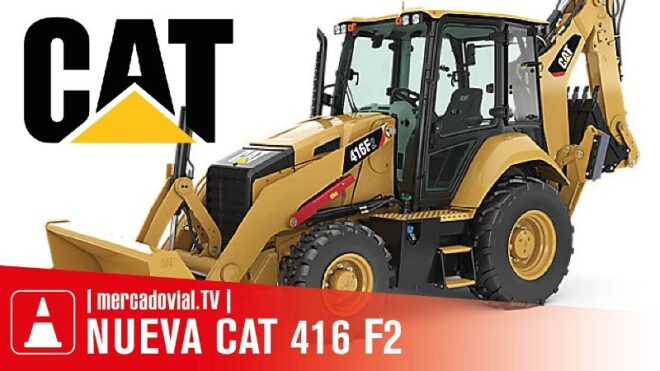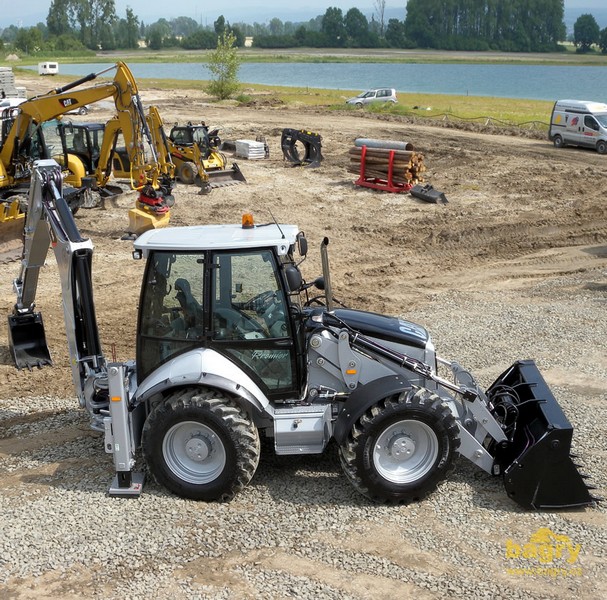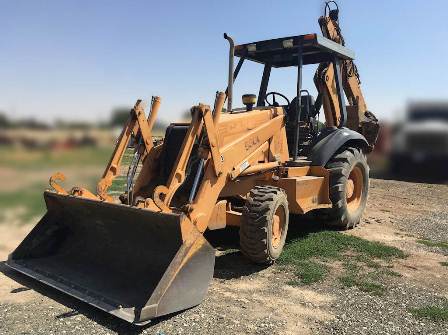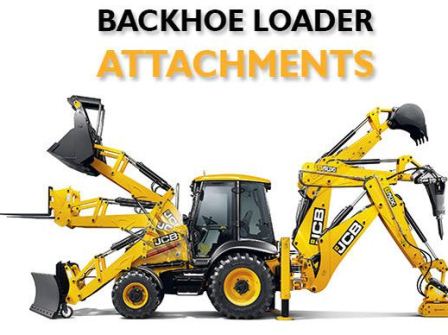CAT backhoes – CAT 416 Backhoe Specs: ingenious, productive, original, durable
For excavation, trenching, filling and material handling capacity, the Caterpillar line of backhoe loaders is certainly strong in those aspects.

CAT backhoe
To illustrate this, the series of Cat F2 backhoes are very ingenious and spacious. The five models of the line join the other Cat backhoe loaders available, the 416E and the 450F of 127 hp, with an excavation depth of 17 feet.
With two engine offers and a range of power levels, the F2 Cat features a powerful hydraulic system and lifting performance.
You can also add a hydromechanical tool with auxiliary lines of combined function or a hydraulic thumb to increase the functionality of the machine.

Caterpillar backhoe models
Each model of the F2 series (415F2, 415F2 IL, 414F2, 416F2, 420F2 and 430F2) has a completely redesigned cab that offers better visibility, better cooling, larger seating area, and ample storage space.
In addition, the seal against the elements and an improved safety keyboard immobilizer have been improved on board.
Operators receive both the space to move and a clear field of vision while they work. The coupler of the double-locking backhoe in the F2 is another key benefit.
With this advanced machine, the operator does not need to leave the cab to install a locking bar or pins when connecting the buckets to the hydraulic coupler.
In addition, the secondary locking system is automatically activated when a tool is attached.
The secure grip of the coupler in each working tool helps reduce the costs of ownership and operation.
Retro Caterpillar
- The hydraulic load sensing system in the Cat backhoe line maintains maximum power and precision operation in its Standard and Economy modes.
- The improved hydraulic system provides more power faster, along with a faster hydraulic output, even at low engine speeds.
- The line runs at the right speed for the given application.
- The variable flow system deftly adapts the pressure and flow of the pump to the demands of each job, unlike the fixed displacement pump systems in some backhoes that pump oil constantly, wasting large amounts of fuel.

Caterpillar products
Will backhoes still be popular?
Many contractors have started using more specialized machines such as mini excavators and skid steer loaders for jobs that used to belong to backhoes.
Although it is still a general-purpose tool, the important question seems to be:
Will backhoes continue to play an important role in most construction projects?
Construction contractors firmly believe that they will. “There are two things that a backhoe really has in its favor”,
- “First, the ability to drive to the workplace eliminates the need for a truck or trailer to transport it, which makes it perfect for owner-operators who provide services in the local community.”
- “Second, the versatility that backhoe offers is still hard to match.”
“You can achieve almost everything required by most work sites. An excavator can dig a trench a little faster than a backhoe, but the loader bucket will dig in the basement much faster and load the trucks in the process.
As they are also compact, they can lead to small worksites that can be difficult for other vehicles.
Then, the forks of the backhoe can handle palletized loads in a few minutes. “
Heavy machinery caterpillar
- Cat equipment sets the standard for our industry.
- The Cat product line of more than 300 machines reflects an increased focus on customer success.
- is the leader in helping its clients, to satisfy their needs with durable and reliable equipment.
- Caterpillar has the best distribution and product support system in any capital goods industry.
Expansion in developing markets
Caterpillar built its first Russian facility in the town of Tosno, located near St. Petersburg, Russia. It was completed in 16 months, occupied in November 1999, and began fabricating machine components in 2000. It had the first electrical substation built in the Leningrad Oblast since the Communist government was dissolved on December 26, 1991. The facility was built under harsh winter conditions, where the temperature was below −13 °F (−25 °C). The facility construction was managed by the Lemminkäinen Group located in Helsinki, Finland.
The $125M Caterpillar Suzhou, People’s Republic of China facility, manufactures medium wheel loaders and motor graders, primarily for the Asian market. The first machine was scheduled for production in March 2009. URS Ausino, in San Francisco, California, manages facility construction.
Caterpillar has manufactured in Brazil since 1960. In 2010 the company announced plans to further expand production of a backhoe and small wheel loaders with a new factory.
What is a backhoe?
If you were to ask a large group of people what they could tell you about backhoe loaders, a lot of them woulddon’t know what you were talking about. We’ve all seen backhoe loaders, commonly called backhoes.
They are used for a number of different jobs and are often the only piece of heavy equipment at a construction site. We pass them on the side of the road all the time. But even somebody who has passed by dozens of backhoes may not know that much about them.
What exactly do they do?
Why are they used for so many different sorts of construction projects?
How can they dig such big holes in such a short amount of time?
How strong are they?
Each piece of equipment is suited to a particular sort of work. On a typical construction site, the backhoe operator usually uses all three components to get the job done.
Backhoe parts
The Tractor
The core structure of a backhoe loader is the tractor. Just like the tractors that farmers use in their fields, the backhoe tractor is designed to move easily over all kinds of rough terrain.
It has a powerful, turbocharged diesel engine, large, rugged tires and a cab with basic steering controls (a steering wheel, brakes, etc.). Backhoe cabs are either completely enclosed or have an open canopy structure to give the operator protection.
The Loader
The loader is attached in the front and the backhoe is attached in the back. These two components serve very different functions. The loader can do several different things. In many applications, you use it like a big, powerful dustpan or coffee scoop.
You usually don’t dig with it; you mostly use it to pick up and carry large amounts of loose material. It’s also used to smooth things over like a butter knife, or to push dirt like a plow. The operator controls the loader while driving the tractor.
The Backhoe
The backhoe is the main tool of the backhoe loader. It’s used to dig up hard, compact material, usually earth, or to lift heavy loads, such as a sewer box. It can lift this material and drop it in a pile to the side of the hole.
Basically, the backhoe is a big, extremely powerful version of your arm or finger. It has three segments:
- The boom
- The stick
- The bucket
The backhoe segments are connected by three joints, comparable to your wrist, elbow, and shoulder. The backhoe moves in pretty much the same way as your arm. In a Caterpillar® backhoe, the boom is bent upward to make it easier to dig with obstacles in the way. This design also provides extra space for the bucket when the operator curls it in with a full load.
The backhoe can dig all sorts of holes but is especially suited for digging ditches. To use the backhoe, the operator has to park the tractor and turn the seat around.
Backhoe attachment
What do the tractor, loader, and backhoe have to do with each other? The tractor component is for moving the other two components from place to place, and the operator also maneuvers it when using the loader.
The loader and backhoe components are a natural combination for all sorts of jobs. When you dig up a lot of dirt to make a ditch or any other sort of hole, you generally need a loader to either move the dirt out of the area or to fill the dirt back in once you’ve got the pipes, power lines, etc. in position.
The most common application for a backhoe loader is this basic job: digging a trench with the backhoe and then back-filling it with the loader.
What makes Caterpillar?
Caterpillar is the world’s leading manufacturer of construction and mining equipment, diesel and natural gas engines, industrial gas turbines, and diesel-electric locomotives.
While most Caterpillar machines are manufactured in the Midwest in the USA, some of the company’s other leading manufacturing plants are located in Russia, China, and Brazil. Caterpillar moved its headquarters closer from Chicago to Deerfield, Illinois, a few miles north of the city.
Heavy equipment refers to heavy-duty vehicles, specially designed for executing construction tasks, most frequently ones involving earthwork operations. They are also known as heavy machines, heavy trucks, construction equipment, engineering equipment, heavy vehicles, or heavy hydraulics.
The primary reason is yellow is considered to be cautious. Usually yellow and the red color represents the alertness and dangerous. since the equipment used in construction sites are heavy and dangerous so they use this color for equipment. Many accidents in constructions took place due to these heavy moving vehicles.
Used Wheel Loaders for sale
The most read

Backhoe Loader Specifications
A backhoe is a type of excavating equipment, or digger, consisting of a digging bucket on the end of a two-part articulated arm.

Backhoe Bucket Attachment
The backhoe is the main tool of the backhoe loader. It’s used to dig up hard, compact material, usually earth, or to lift heavy loads, such as a sewer box.
